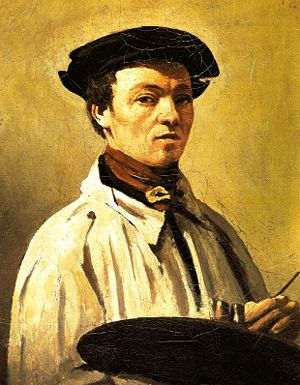(Paris, July the 17th, 1796 - February the 22nd, 1875)
Jean-Baptiste-Camille Corot was a French painter whose father was a wigmaker married with Francesca Oberson (from Friburg, Switzerland), who was a dressmaker. The store of his father had an enviable reputation during the Empire period and the Restoration. Corot enjoyed a half grant that was given by the imperial government. He dropped out the classical education, which he seemed to feel not inclined to, in order to begin to work needlessly and regularly in the textile industry for six years. It was just to please his father, whose wish was to earmark 100.000 francs for establishing Corot.
Admitting that Corot was unsuited to the trade and considering his artistic liking, the textile workers Delalain, who were his employers, managed to do that Corot was allowed by his father to paint for a living (1821). His father granted him with 1,200 francs a year. But his father did not admit Corot’s talent till he was appointed Knight (Chevalier) of the Legion of Honour in 1846.
Corot frequented the studio of Michallon, who passed away a little time after. He also frequented for three years the studio of Jean-Victor Bertin, whose father was the founder of the Journal des Débats. Bertin was inspector of the Beaux Arts in 1845. After giving his father a self-portrait, which was a precise condition to provide him the money he needed, in 1826, Corot travelled to Italy for the first time. In Rome, he met Bertin, Leopolo Robert, Schnetz, Bodinier, Reinhart, Lapito and Carnelle d’Aligny. Carnelle d’Aligny encouraged Corot and proclaimed that Corot’s Coloseum was a masterpiece and that the author was a great painter in the Greco café and della Lepre, which were places very frequented by the artists of that time. The little canvas Coloseum, which is preserved in The Louvre Museum, proves that the shrewd friend of the artist was right.
During his stay in Italy he worked in Albano and its surroundings: Narni, Rocca di Papa, Ariccia, Frascai, Marino, Cervara, Nemi, Civitella, Subiaco, Olevano, Civita Castellana, Naples, Ischia and Capri. He went back to Paris in 1828 after visiting Venice. When he returned, Corot started a long series of excursions and trips to investigate that allowed him to look into all the aspects of the French scenery. He showed a special predilection for the Fontainebleau forests, the Normandy valleys and the Ville-d’Avray fronds, where his family owned a house that later became Corot’s usual residence.
Corot exhibited his works in the Paris Salon for the first time in 1827, being awarded a second-class medal in 1831 and seeing how his artworks were refused after being challenged by the best museums and the wealthiest collectors. In 1838 the Duke of Orleans purchased two canvases by Corot, but the opposition of other painters, who nowadays are unknown, persecuted him till 1846, when he was decorated.
The events that came after in the political regime of France placed Charles Blanc as the director of the department for the visual arts. Charles Blanc was a very worthy person that put an end to the privileges of the artistic cliques and that rewarded with its exact value the artworks by Díaz de la Peña, Rousseau, Isabey, Decamps and Delacroix. Corot was elected member of the jury. In 1849 and 1850 the state purchased the works An Orchard at Harvest Time and Morning. In 1859, in Bordeaux, Corot exhibited one of his artworks, which had been previously exhibited in the Universal Exhibition of 1855, and it was purchased by the Municipal Museum.
His catalogue contains 2,500 artworks. Among his works we can find a big quantity of paintings with figures. He distinguished himself by these figures so much so that he was compared to Van der Meer. Among his best works we can find Young Girl with a Large Cap on Her Head, La Bacchante, Diana, Agostina, Young Woman with a Mandolin, Gipsy with a Basque Tamborine and other works that are more unknown. These admirable landscapes which were models of luminosity, environment and poetry have influenced on the artworks by several artists so remarkable and as outstanding as Daubigny, Lépine, Claudio Monet, and Pissarro.


